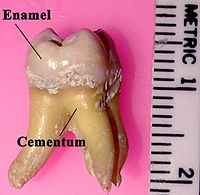
Photo from wikipedia
This study evaluated the etching pattern, surface microhardness, and bond strength for enamel and dentin submitted to treatment with phosphoric, glycolic, and ferulic acids. Enamel and dentin blocks were treated… Click to show full abstract
This study evaluated the etching pattern, surface microhardness, and bond strength for enamel and dentin submitted to treatment with phosphoric, glycolic, and ferulic acids. Enamel and dentin blocks were treated with phosphoric, glycolic, and ferulic acid to evaluate the surface and adhesive interface by scanning electron microscopy (2000×). Surface microhardness (Knoop) was evaluated before and after etching, and microtensile bond strength was evaluated after application of a two-step adhesive system (Adper Single Bond 2, 3M ESPE) at 24 hours and 12 months storage time points. Analysis of variance (ANOVA) and Tukey's test showed a decrease in the microhardness values for both substrates after application of each acid (p<0.0001). The reduction percentage was significantly higher for enamel treated with phosphoric acid (59.9%) and glycolic acid (65.1%) than for ferulic acid (16.5%) (p<0.0001), and higher for dentin that received phosphoric acid (38.3%) versus glycolic acid (27.8%) and ferulic acid (21.9%) (p<0.0001). Phosphoric and glycolic acids led to homogeneous enamel demineralization, and promoted the opening of dentinal tubules, whereas ferulic acid led to enamel surface demineralization and partially removed the smear layer. The adhesive-enamel interface showed micromechanical embedding of the adhesive in the interprismatic spaces when phosphoric and glycolic acids were applied. Ferulic acid showed no tag formation. Microtensile bond strength at both time points, and for both substrates, was lower with ferulic acid (p=0.0003/E; p=0.0011/D; Kruskal Wallis and Dunn). The bond strength for enamel and dentin decreased when using phosphoric and glycolic acids at the 12-month time evaluation (p<0.05). Glycolic acid showed an etching pattern and microhardness similar to that of phosphoric acid. Ferulic acid was not effective in etching the enamel or dentin, and it did not provide satisfactory bond strength to dental substrates.
Journal Title: Operative dentistry
Year Published: 2023
Link to full text (if available)
Share on Social Media: Sign Up to like & get
recommendations!